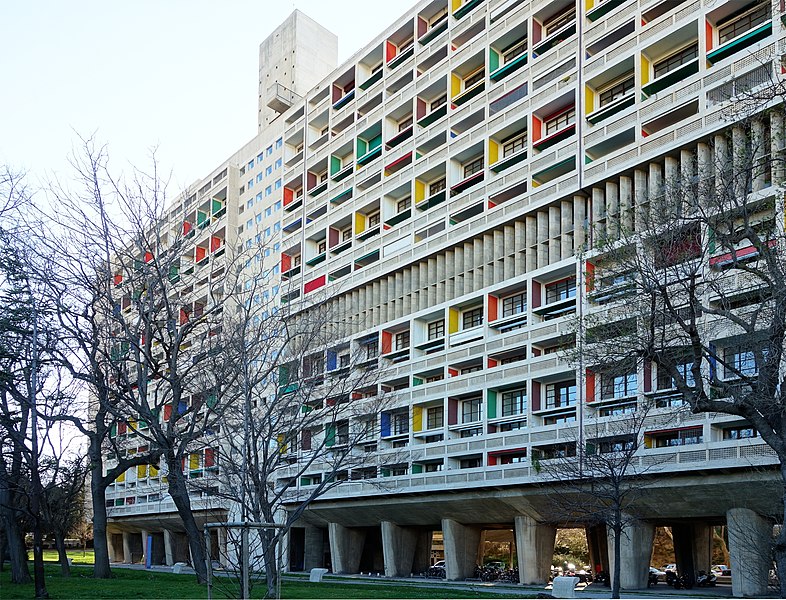Cite Radieuse
Cite Radieuse (Radiant City), is a high-density residential development, characteristic of the Unite d’habitation concept design developed by Le Corbusier.
Located in Marseille, France, Cite Radieuse is arguably the most influential Brutalist building of all time, and is considered one of Le Corbusier’s most famous and successful works. Indeed, the building is often credited as being the initial inspiration behind the architectural style of Brutalism.
Built between 1947 and 1952, the design applied Le Corbusier’s famous dictum that a house was a ‘machine for living in’, to an entire community. In so doing, it redefined high-density housing by creating a self-contained 18-storey block structured like an ocean liner.
The building is situated at the centre of a large urban park, and is 165 m long and 56 m high.
Departing from his trademark smooth white surfaces, Le Corbusier chose to construct the building in beton brut (rough-cast concrete), textured by the timber formwork. This was a matter of expediency, since a steel frame would have been too expensive considering post-WW2 material shortages, but subsequently became a design staple of Brutalism.
The building is raised up off the ground on chunky concrete piloti, and its long elevations comprise a series of balconies and deep-set windows that create a strong visual grid. Le Corbusier based this grid on his Modulor Man concept of measurement that he created to achieve designs based on human proportions.
Corridors extend through the centre of the long axis on every third floor of the building, referred to as ‘internal streets’. Most of the 337 apartments are arranged as 2-storey duplexes with a double-height living room at one end, stretching from one side to the other. Pairs of apartments interlock around the central access corridor. The apartments accommodate 1,600 residents, and the building also includes shops, sport and medical facilities, a hotel and restaurant.
Le Corbusier designed the building’s flat roof to serve as a communal terrace, together with sculptural ventilation stacks, a running track and children’s paddling pool.
When the building was unveiled, it was immediately celebrated by the architectural community as a success. The architect Walter Gropius is reported to have said at the opening event, “any architect who does not find this building beautiful, had better lay down his pencil.”
Despite influencing countless system-built residential blocks, the concept has frequently proven unsuccessful elsewhere, with some theorising this was becuase the generous proportions of Cite Radieuse were not adopted.
Between 2010 and 2013, the roof underwent renovation, and an exhibition centre was created. In 2016, it was designated a UNESCO World Heritage Site and was classified as a historic monument by the French Ministry of Culture.
[edit] Related articles on Designing Buildings Wiki
Featured articles and news
Key points for construction at a glance with industry reactions.
Functionality, visibility and sustainability
The simpler approach to specification.
Architects, architecture, buildings, and inspiration in film
The close ties between makers and the movies, with our long list of suggested viewing.
SELECT three-point plan for action issued to MSPs
Call for Scottish regulation, green skills and recognition of electrotechnical industry as part of a manifesto for Scottish Parliamentary elections.
UCEM becomes the University of the Built Environment
Major milestone in its 106-year history, follows recent merger with London School of Architecture (LSE).
Professional practical experience for Architects in training
The long process to transform the nature of education and professional practical experience in the Architecture profession following recent reports.
A people-first approach to retrofit
Moving away from the destructive paradigm of fabric-first.
International Electrician Day, 10 June 2025
Celebrating the role of electrical engineers from André-Marie Amperè, today and for the future.
New guide for clients launched at Houses of Parliament
'There has never been a more important time for clients to step up and ...ask the right questions'
The impact of recycled slate tiles
Innovation across the decades.
EPC changes for existing buildings
Changes and their context as the new RdSAP methodology comes into use from 15 June.
Skills England publishes Sector skills needs assessments
Priority areas relating to the built environment highlighted and described in brief.
BSRIA HVAC Market Watch - May 2025 Edition
Heat Pump Market Outlook: Policy, Performance & Refrigerant Trends for 2025–2028.
Committing to EDI in construction with CIOB
Built Environment professional bodies deepen commitment to EDI with two new signatories: CIAT and CICES.
Government Grenfell progress report at a glance
Line by line recomendation overview, with links to more details.
An engaging and lively review of his professional life.
Sustainable heating for listed buildings
A problem that needs to be approached intelligently.
50th Golden anniversary ECA Edmundson apprentice award
Deadline for entries has been extended to Friday 27 June, so don't miss out!
CIAT at the London Festival of Architecture
Designing for Everyone: Breaking Barriers in Inclusive Architecture.
Mixed reactions to apprenticeship and skills reform 2025
A 'welcome shift' for some and a 'backwards step' for others.




























Comments
The featured building is NOT the Cité Radieuse in Marseille, but apparently the Housing Unit built by Le Corbusier upon the same blue print in Briey la Forêt in Eastern France. Five Housing Units were built, including the one in Marseille (1946-52), Rezé (1953-55), West Berlin (1957-58), Briey La Forêt (1959-60) and the latest in Firminy (1965-67). The one in Marseille is the only one encapsulating all principles of the vertical city (Public School, roof top opened to public, public spaces, shops and spaces for profesional activities...). It now also host an international art center (MAMO) and a Third space for architecture (Kolektiv Cité Radieuse). All Housing Units are UNESCO listed since 2016.
Maxime Forest, Kolektiv Cité Radieuse Marseille
Thank you for offering this correction. The image has been updated.
--Editor, Designing Buildings